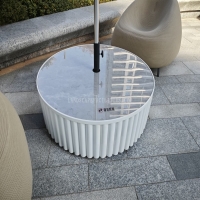Welcome to the website for landscape facilities products and knowledge.
How does the table’s design ensure it remains stable during active use, such as leaning?
Modern table designs incorporate multiple engineering principles to maintain stability during active use, particularly when users lean on them. The foundation of this stability begins with strategically engineered leg structures that feature reinforced joints and strategic bracing systems. Manufacturers utilize high-strength materials like solid hardwood, reinforced steel, or advanced polymers that resist flexing under pressure.
The geometry of table legs plays a crucial role in stability management. Many contemporary designs feature tapered legs that widen toward the base, creating a broader support platform that effectively counters lateral forces when pressure is applied. Additionally, cross-bracing systems installed beneath the table surface distribute leaning forces evenly across the entire structure, preventing concentrated stress points that could compromise stability.
Weight distribution represents another critical factor in table stability. Designers carefully calculate the center of gravity, often adding mass to the table's base through thicker materials or additional supportive elements. This lower center of gravity creates a pendulum effect that naturally resists tipping, even when significant weight is applied to the table's edges.
Advanced manufacturing techniques further enhance stability through precision joinery. Mortise and tenon joints, reinforced corner brackets, and epoxy-based adhesives create connections that withstand both vertical loads and horizontal stresses. Some premium tables incorporate tension-based stabilization systems with integrated cables or bars that actively counterbalance leaning forces.
Surface material selection also contributes significantly to overall stability. Rigid tabletop materials like laminated composites, thick solid wood, or tempered glass maintain structural integrity when pressure is applied. These materials resist warping or bending that could gradually compromise the table's stability over time.
For tables intended for high-activity environments, many manufacturers incorporate additional stabilization features such as adjustable leveling feet that compensate for uneven floors, anti-slip padding on bottom surfaces, and widened leg placements that extend beyond the table's perimeter. These design elements work collectively to ensure the table remains securely positioned during various uses, from casual leaning to more dynamic activities.
The testing protocols for table stability have likewise evolved, with manufacturers conducting simulated leaning scenarios using standardized weight distributions and movement patterns. This rigorous testing ensures tables meet or exceed international safety standards while providing users with confidence in their furniture's reliability during active use scenarios.
Related search:

Recommendation
Round metal tube border design table with tempered glass or granite countertop on the top.